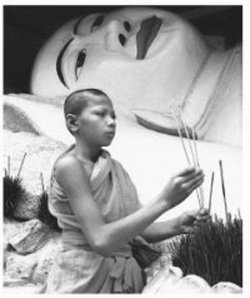Difference between revisions of "Three Clarities"
Jump to navigation
Jump to search
(Created page with "thumb|250px| <poem> '''Three Clarities''' (三明). An Arhat has achieved (1) clear knowledge of the past lives of self and others and their causes and...") |
|||
| Line 1: | Line 1: | ||
[[File:Incense.jpg|thumb|250px|]] | [[File:Incense.jpg|thumb|250px|]] | ||
<poem> | <poem> | ||
| − | + | [[Three Clarities]] ([[三明]]). An [[Arhat]] has achieved | |
| − | (1) clear knowledge of the past lives of self and others and their causes and conditions, | + | (1) clear [[knowledge]] of the past [[lives]] of [[self]] and others and their [[causes]] and [[conditions]], |
| − | (2) clarity of his god-eye that sees others’ future lives and their causes and conditions, and | + | (2) clarity of his god-eye that sees others’ future [[lives]] and their [[causes]] and [[conditions]], and |
| − | (3) clear knowledge that his afflictions have ceased and will never arise again. | + | (3) clear [[knowledge]] that his [[afflictions]] have ceased and will never arise again. |
| − | The Three Clarities of a Buddha are supreme and are called the Three Supreme Clarities (三達). | + | The Three Clarities of a [[Buddha]] are supreme and are called the Three Supreme Clarities (三達). |
</poem> | </poem> | ||
{{R}} | {{R}} | ||
Revision as of 22:19, 25 August 2013
Three Clarities (三明). An Arhat has achieved
(1) clear knowledge of the past lives of self and others and their causes and conditions,
(2) clarity of his god-eye that sees others’ future lives and their causes and conditions, and
(3) clear knowledge that his afflictions have ceased and will never arise again.
The Three Clarities of a Buddha are supreme and are called the Three Supreme Clarities (三達).
